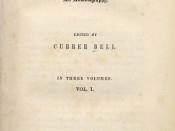Clearly, every individual reader perceives a text in a different way; it is the result of our different upbringings and our different social, cultural and moral choices. From a mathematical viewpoint, if a single reader is able to draw two different sets of meanings from a text, then there are more unique interpretations of the text than there are readers. Charlotte Bronte's 19th century masterpiece, "Jane Eyre", is a useful textual example to how these meanings may differ from reader to reader and, indeed, from different readings by the same reader. As will be seen, many different interpretations can arise from the same section of the text - differences in our observation of the themes and symbols used in "Jane Eyre", coupled with our ability to imagine further - to construct a boundless number of opinions, views and, indeed, literary "eye lenses" through which one may examine a text.
Jane Eyre is not only a fable about a girl, but a modern feminist plea, as in the opinion of Pauline Nestor, author of Striking A Balance. In this respect, the novel fundamentally justifies the view that a text may be interpreted in as many ways as there are readers.
Bronte's depiction of Jane's upbringing can be seen simply as a story about her sufferings as a young girl and her struggles with authoritarian figures at school, such as Brocklehurst, all the while searching for equality. Mrs. Reed plays Jane's guardian who, through numerous socio-economic means, controls Jane's development as a person and the extent of her power in the household. Bronte's prose does not take the reader outside the Reed household; in fact, Jane's situation is depicted entirely as a consequence of her status and relationship with members of the Reed family. The reader is told that...


